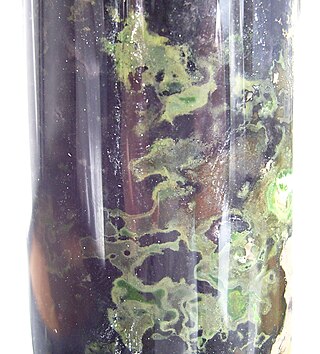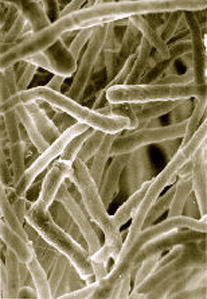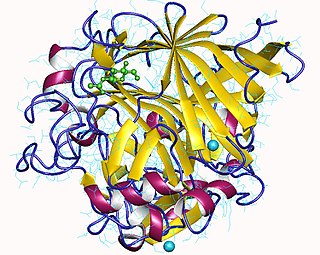Related Research Articles

Ruminants are herbivorous grazing or browsing artiodactyls belonging to the suborder Ruminantia that are able to acquire nutrients from plant-based food by fermenting it in a specialized stomach prior to digestion, principally through microbial actions. The process, which takes place in the front part of the digestive system and therefore is called foregut fermentation, typically requires the fermented ingesta to be regurgitated and chewed again. The process of rechewing the cud to further break down plant matter and stimulate digestion is called rumination. The word "ruminant" comes from the Latin ruminare, which means "to chew over again".

Cellulase is any of several enzymes produced chiefly by fungi, bacteria, and protozoans that catalyze cellulolysis, the decomposition of cellulose and of some related polysaccharides:

The phylum Bacteroidota is composed of three large classes of Gram-negative, nonsporeforming, anaerobic or aerobic, and rod-shaped bacteria that are widely distributed in the environment, including in soil, sediments, and sea water, as well as in the guts and on the skin of animals.

Chlorobium is a genus of green sulfur bacteria. They are photolithotrophic oxidizers of sulfur and most notably utilise a noncyclic electron transport chain to reduce NAD+. Photosynthesis is achieved using a Type 1 Reaction Centre using bacteriochlorophyll (BChl) a. Two photosynthetic antenna complexes aid in light absorption: the Fenna-Matthews-Olson complex, and the chlorosomes which employ mostly BChl c, d, or e. Hydrogen sulfide is used as an electron source and carbon dioxide its carbon source.
The rumen, also known as a paunch, is the largest stomach compartment in ruminants and the larger part of the reticulorumen, which is the first chamber in the alimentary canal of ruminant animals. The rumen's microbial favoring environment allows it to serve as the primary site for microbial fermentation of ingested feed. The smaller part of the reticulorumen is the reticulum, which is fully continuous with the rumen, but differs from it with regard to the texture of its lining.
Fibrobacterota is a small bacterial phylum which includes many of the major rumen bacteria, allowing for the degradation of plant-based cellulose in ruminant animals. Members of this phylum were categorized in other phyla. The genus Fibrobacter was removed from the genus Bacteroides in 1988.
Cellulosomes are multi-enzyme extracellular complexes. Cellulosomes are associated with the cell surface and mediate cell attachment to insoluble substrates and degrade them to soluble products which are then absorbed. Cellulosome complexes are intricate, multi-enzyme machines, produced by many cellulolytic microorganisms. They are produced by microorganisms for efficient degradation of plant cell wall polysaccharides, notably cellulose, the most abundant organic polymer on Earth. The multiple subunits of cellulosomes are composed of numerous functional domains that interact with each other and with the cellulosic substrate. One of these subunits, a large glycoprotein "scaffoldin", is a distinctive class of non-catalytic scaffolding polypeptides. The scaffoldin subunit selectively integrates the various cellulases and xylanase subunits into the cohesive complex, by combining its cohesin domains with a typical dockerin domain present on each of the subunit enzymes. The scaffoldin of some cellulosomes, an example being that of Clostridium thermocellum, contains a carbohydrate-binding module that adheres cellulose to the cellulosomal complex.

Lignocellulose refers to plant dry matter (biomass), so called lignocellulosic biomass. It is the most abundantly available raw material on the Earth for the production of biofuels. It is composed of two kinds of carbohydrate polymers, cellulose and hemicellulose, and an aromatic-rich polymer called lignin. Any biomass rich in cellulose, hemicelluloses, and lignin are commonly referred to as lignocellulosic biomass. Each component has a distinct chemical behavior. Being a composite of three very different components makes the processing of lignocellulose challenging. The evolved resistance to degradation or even separation is referred to as recalcitrance. Overcoming this recalcitrance to produce useful, high value products requires a combination of heat, chemicals, enzymes, and microorganisms. These carbohydrate-containing polymers contain different sugar monomers and they are covalently bound to lignin.

The PVC superphylum is a superphylum of bacteria named after its three important members, Planctomycetota, Verrucomicrobiota, and Chlamydiota. Cavalier-Smith postulated that the PVC bacteria probably lost or reduced their peptidoglycan cell wall twice. It has been hypothesised that a member of the PVC clade might have been the host cell in the endosymbiotic event that gave rise to the first proto-eukaryotic cell.

Trichoderma reesei is a mesophilic and filamentous fungus. It is an anamorph of the fungus Hypocrea jecorina. T. reesei can secrete large amounts of cellulolytic enzymes. Microbial cellulases have industrial application in the conversion of cellulose, a major component of plant biomass, into glucose.

The order Flavobacteriales comprises several families of environmental bacteria.

Cytophaga is a genus of Gram-negative, gliding, rod-shaped bacteria. This bacterium is commonly found in soil, rapidly digests crystalline cellulose C. hutchinsonii is able to use its gliding motility to move quickly over surfaces. Although the mechanism for this is not known, there is a belief that the flagellum is not used
Fibrolytic bacteria constitute a group of microorganisms that are able to process complex plant polysaccharides thanks to their capacity to synthesize cellulolytic and hemicellulolytic enzymes. Polysaccharides are present in plant cellular cell walls in a compact fiber form where they are mainly composed of cellulose and hemicellulose.
Conserved signature inserts and deletions (CSIs) in protein sequences provide an important category of molecular markers for understanding phylogenetic relationships. CSIs, brought about by rare genetic changes, provide useful phylogenetic markers that are generally of defined size and they are flanked on both sides by conserved regions to ensure their reliability. While indels can be arbitrary inserts or deletions, CSIs are defined as only those protein indels that are present within conserved regions of the protein.

Cellulose 1,4-β-cellobiosidase is an enzyme of interest for its capability of converting cellulose to useful chemicals, particularly cellulosic ethanol.

Extracellular enzymes or exoenzymes are synthesized inside the cell and then secreted outside the cell, where their function is to break down complex macromolecules into smaller units to be taken up by the cell for growth and assimilation. These enzymes degrade complex organic matter such as cellulose and hemicellulose into simple sugars that enzyme-producing organisms use as a source of carbon, energy, and nutrients. Grouped as hydrolases, lyases, oxidoreductases and transferases, these extracellular enzymes control soil enzyme activity through efficient degradation of biopolymers.
Neocallimastix patriciarum is a species of fungus that lives in the rumen of sheep and other ruminant species. N. patriciarum is an obligate anaerobe and is an important component of the microbial population within the rumen. Only one of a few rumen fungi, this species is interesting and unique within the fungal world. Originally thought to be a flagellate protists, species within the phylum Neocallimastigomycota were first recognized as a fungus by Colin Orpin in 1975 when he demonstrated that they had cell walls of chitin
Methanogens are a group of microorganisms that produce methane as a byproduct of their metabolism. They play an important role in the digestive system of ruminants. The digestive tract of ruminants contains four major parts: rumen, reticulum, omasum and abomasum. The food with saliva first passes to the rumen for breaking into smaller particles and then moves to the reticulum, where the food is broken into further smaller particles. Any indigestible particles are sent back to the rumen for rechewing. The majority of anaerobic microbes assisting the cellulose breakdown occupy the rumen and initiate the fermentation process. The animal absorbs the fatty acids, vitamins and nutrient content on passing the partially digested food from the rumen to the omasum. This decreases the pH level and initiates the release of enzymes for further breakdown of the food which later passes to the abomasum to absorb remaining nutrients before excretion. This process takes about 9–12 hours.
Cytophaga hutchinsonii is a bacterial species in the genus Cytophaga. C. hutchinsonii is an aerobic, gram-negative, soil, microorganism that exhibits gliding motility, enabling it to move quickly over surfaces and is capable of cellulose degradation.
Cytophagales is an order of non-spore forming, rod-shaped, Gram-negative bacteria that move through a gliding or flexing motion. These chemoorganotrophs are important remineralizers of organic materials into micronutrients. They are widely dispersed in the environment, found in ecosystems including soil, freshwater, seawater and sea ice. Cytophagales is included in the Bacteroidota phylum.
References
- 1 2 3 Suen G, Weimer PJ, Stevenson DM, Aylward FO, Boyum J, Deneke J, et al. (April 2011). "The complete genome sequence of Fibrobacter succinogenes S85 reveals a cellulolytic and metabolic specialist". PLOS ONE. 6 (4): e18814. Bibcode:2011PLoSO...618814S. doi: 10.1371/journal.pone.0018814 . PMC 3079729 . PMID 21526192.
- ↑ Burnet MC, Dohnalkova AC, Neumann AP, Lipton MS, Smith RD, Suen G, Callister SJ (2 December 2015). "Evaluating Models of Cellulose Degradation by Fibrobacter succinogenes S85". PLOS ONE. 10 (12): e0143809. Bibcode:2015PLoSO..1043809B. doi: 10.1371/journal.pone.0143809 . PMC 4668043 . PMID 26629814.
- 1 2 3 Bryant MP, Doetsch RN (1 October 1954). "A Study of Actively Cellulolytic Rod-Shaped Bacteria of the Bovine Rumen". Journal of Dairy Science. 37 (10): 1176–1183. doi: 10.3168/jds.S0022-0302(54)91387-9 . ISSN 0022-0302.
- ↑ Béra-Maillet C, Ribot Y, Forano E (April 2004). "Fiber-degrading systems of different strains of the genus Fibrobacter". Applied and Environmental Microbiology. 70 (4): 2172–2179. Bibcode:2004ApEnM..70.2172B. doi:10.1128/AEM.70.4.2172-2179.2004. PMC 383150 . PMID 15066810.
- 1 2 Gupta RS (2008). "The phylogeny and signature sequences characteristics of Fibrobacteres, Chlorobi, and Bacteroidetes". Critical Reviews in Microbiology. 30 (2): 123–143. doi:10.1080/10408410490435133. PMID 15239383. S2CID 24565648.
- ↑ Griffiths E, Gupta RS (September 2001). "The use of signature sequences in different proteins to determine the relative branching order of bacterial divisions: evidence that Fibrobacter diverged at a similar time to Chlamydia and the Cytophaga-Flavobacterium-Bacteroides division". Microbiology. 147 (Pt 9): 2611–2622. doi: 10.1099/00221287-147-9-2611 . PMID 11535801.
- 1 2 Gupta RS, Lorenzini E (May 2007). "Phylogeny and molecular signatures (conserved proteins and indels) that are specific for the Bacteroidetes and Chlorobi species". BMC Evolutionary Biology. 7 (1): 71. Bibcode:2007BMCEE...7...71G. doi: 10.1186/1471-2148-7-71 . PMC 1887533 . PMID 17488508.
- 1 2 Raut MP, Couto N, Karunakaran E, Biggs CA, Wright PC (November 2019). "Deciphering the unique cellulose degradation mechanism of the ruminal bacterium Fibrobacter succinogenes S85". Scientific Reports. 9 (1): 16542. Bibcode:2019NatSR...916542R. doi:10.1038/s41598-019-52675-8. PMC 6851124 . PMID 31719545.
- ↑ Palmquist DL (1995). "Digestibility of cotton lint fiber and whole oilseeds by ruminal microorganisms". Animal Feed Science and Technology. 56 (3–4): 231–42. doi:10.1016/0377-8401(95)00830-6.
- ↑ Raut MP, Couto N, Karunakaran E, Biggs CA, Wright PC (November 2019). "Deciphering the unique cellulose degradation mechanism of the ruminal bacterium Fibrobacter succinogenes S85". Scientific Reports. 9 (1): 16542. Bibcode:2019NatSR...916542R. doi:10.1038/s41598-019-52675-8. PMC 6851124 . PMID 31719545.